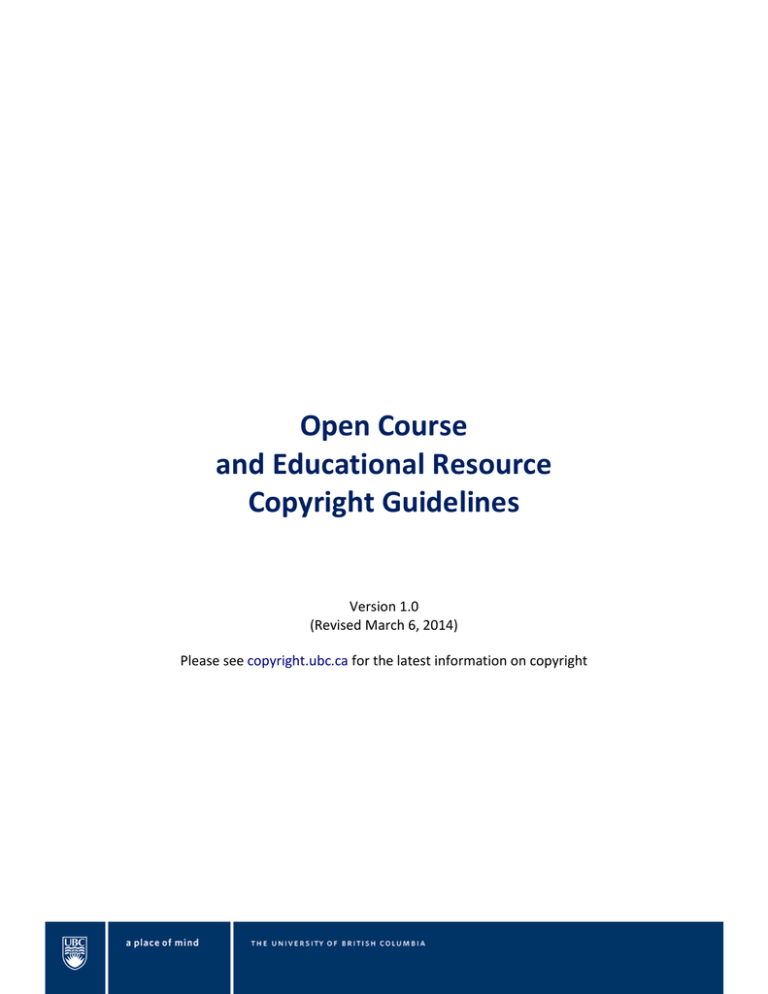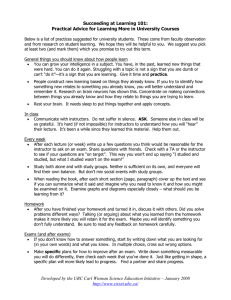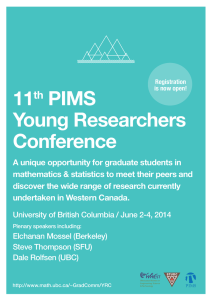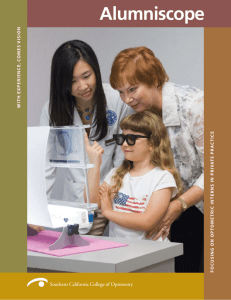Open Course and Educational Resource Copyright Guidelines
advertisement

Open Course and Educational Resource Copyright Guidelines Version 1.0 (Revised March 6, 2014) Please see copyright.ubc.ca for the latest information on copyright Introduction To create and preserve knowledge in a way that opens and facilitates the dissemination of knowledge to the world, UBC instructors are encouraged to utilize Creative Commons licenses, digital repositories and other open access channels to distribute their teaching materials broadly. These guidelines are intended to help instructors and course support teams make responsible use of third-party copyrighted materials1 in courses or in educational resources that will be shared openly on the Internet. If you have questions about the information in these guidelines or how it applies to specific usecase scenarios, please contact the Scholarly Communications & Copyright Office (SCCO) at copyright.services@ubc.ca or 604-827-2006. For general copyright information, including what it covers, how long it lasts, how you get permission to use someone’s copyrighted material, and how it works internationally, please see UBC’s Copyright Basics FAQ. 1. Copyright in Open Environments Many instructors choose to make their teaching and learning materials, resources or full courses publicly available online, which means that anyone with an Internet connection can access and view the resources. This means that when instructors post content openly on the Internet, they are effectively publishing that content online for a global audience. Using copyrighted materials in an open environment requires more diligence than using those same materials in a classroom or learning management system at UBC. Since the audience is not limited to registered students, the use of third-party copyrighted material is more likely to require the permission of the copyright owner(s), and the inappropriate use of such material is more likely to generate complaints. Further, many of the educational exceptions that allow classroom use of copyrighted material without permission either do not apply in the open environment or apply only in a limited fashion. 2. General Guidelines2 • Instructors openly sharing teaching and learning materials should use public domain or openly licensed material covered by Creative Commons and other open, free-for-use licences. It is important to review the terms of the open license to ensure that you comply with any restrictions. • For all other copyrighted material, instructors should obtain permission from rights holders. The permission should be in writing (email will suffice). The SCCO will assist with seeking permission, but it is not always possible to contact rights holders. Instructors should submit permission requests to the SCCO at least 10 weeks in advance of when you will need it. Additionally, a file record of who gave the permission, what was permitted, the date, and how to contact the person who gave the permission will need to be kept. The SCCO will also assist in managing permission records. • It is always preferable to hyperlink to materials, rather than copy materials for distribution. Providing a hyperlink is not currently believed to be the same as making a copy or distributing a work, and can be done without permission. • Materials obtained electronically through UBC Library are generally not allowed to be posted on public websites. Wherever possible, instructors should provide access to these materials through persistent links (PURLs). For more information on PURLs, please see these short video tutorials. Please note that most non-UBC students may not able to access these materials. • There are lots of materials available for use in open courses or open educational resources. For details, see the What Copyright Allows You to Copy section below. • In many cases, the best decision might be to simply remove third-party copyrighted content that is not essential to the pedagogy of a learning unit, for example, purely illustrative content. Participants in open courses report that the experience is quite different than in a classroom, and the impact of purely illustrative content is reduced. • Instructors should always provide an attribution to the original source. This acknowledgement can be made at the end of a learning unit or contribution; it need not be included directly where the work is used, if that would harm the flow of the author’s content. • Generally, it is not practical to pay transactional licensing fees for content in open environments. • The fair dealing exception applies in open environments, but there are fewer express educational exceptions to rely upon. See the final section of these guidelines for more information. 3. What Copyright Law Allows You to Copy3 Despite the above restrictions, instructors enjoy “user rights”, which are robust rights to use materials without needing to obtain the copyright owner’s permission, including: A. Your Own Work – Copying and distributing your own work is up to you. Uploading content you have developed is to grant UBC a license to reproduce, sublicense to a third party, distribute, publicly display, publicly perform, enhance, modify, adapt and translate such content (please refer to the Agreement for Content Licensing). Please note, however, that permissions may be nonetheless required if (1) the work contains third-party copyrighted materials, or (2) you’ve transferred your copyright in the work to a third party, as is often the case with published works such as books and articles. B. Insubstantial Portions of Works – Copying quantitatively and qualitatively insubstantial amounts of a work does not require permission or payment. Examples of insubstantial use in an open environment would include quoting a few sentences from an article or book, or a few words from a short poem or song. If quoting more than a few sentences at a time, consider whether the amount copied is substantial (if so, the permission of the copyright owner should be sought). If in doubt, contact the SCCO. C. Material in which Copyright Cannot Exist – Copyright does not protect facts and ideas, it only protects the particular way that an author expresses them. The novel ‘Harry Potter and the Philosopher’s Stone’ is protected by copyright. The idea of a child wizard who confronts an evil wizard is not. Similarly, a textbook on geology may be protected by copyright but the facts in it (about sedimentation, magma, tectonic plates, etc.) are not. D. Material no Longer Protected by Copyright – In Canada, a work’s copyright protection typically ends 50 years after the death of its author, regardless of the citizenship of the author or where the work was originally published. When a work’s copyright protection ends, the work is said to enter the public domain. For more information, please see UBC’s Public Domain Guide. E. Openly Licensed Works – material covered by Creative Commons and other open, free-for-use licenses can be used with minimal restrictions. Note, it is important to review the terms of the license to ensure that you comply with those minimal restrictions. F. Government of Canada Works – Government of Canada material may be reproduced for personal or public noncommercial purposes unless there is a specific indication to the contrary attached to the work. Permission is required to revise, adapt or translate a work or to reproduce it for commercial distribution. Materials produced by other governments in Canada and around the world are subject to similar rules. G. Hyperlinks – Providing an Internet link to a work is not generally considered to be the same as making a copy, so it does not trigger the requirement of permission or payment. 4. Seeking Permission If third-party copyrighted material is integral to the point of the learning unit or contribution, the use is not permitted by the Copyright Act, and replacing the material with an openly licensed or public domain substitute is not an option, then seeking permission will be necessary. Instructors may enlist the SCCO’s assistance in seeking permission. Please note that obtaining permission can take some time, and is not always possible. You will need to be prepared with a backup plan if the copyright owner is unresponsive, cannot be located, or requests an unreasonable fee in return for permission. These obstacles are even more pronounced in open contexts, as many creators and publishers are unfamiliar with open online learning environments and unsure of how to handle related permission requests. For these reasons, we recommend giving yourself a lot of time, and if enlisting the SCCO’s assistance, you should submit your permission requests at least 10 weeks in advance. In the event that permission cannot be obtained, the SCCO is available to assist with finding alternatives. A file record of who gave the permission, what was permitted, the date, and how to contact the person who gave the permission will need to be kept. The SCCO will also assist in managing permission records. If you anticipate needing to seek permission for excerpts from published books or articles, then please note: • Where the instructor is also the author of the work being distributed, the publisher is more likely to grant permission. • Whenever possible, a recommendation to purchase the book from which an excerpt is taken, and a link through which students can make such a purchase, will also encourage the publisher to grant permission. 5. Fair Dealing in Open Environments Introduction: Fair dealing is nuanced and context-dependent. The following sections provide information about fair dealing with respect to certain content, but understand that they are by no means definitive. If you have questions about whether a particular use-case scenario would qualify as fair dealing, please contact the SCCO office. • UBC’s Fair Dealing Requirements apply only to the use of copyrighted material in closed educational environments such as physical classrooms and UBC’s learning management systems, and therefore cannot be relied upon in open environments. • Fair dealing does not apply where a license governs the use of the work and that licence does not permit use pursuant to the fair dealing exception. This is the case with some of the electronic resources obtained through the UBC Library, and with online materials obtained from websites with terms of use or similar legal notices that restrict fair dealing. Images: • When the use of illustrations, graphs and figures is integral to the point of the lesson, and the picture or figure is subjected to sustained commentary and critical assessment, the case for fair dealing is strong. The SCCO can assist with determining if a specific use of an image is permissible under fair-dealing. • In many cases, an openly-licensed substitute (such as a picture carrying a Creative Commons license) or an image in the public domain can be found for those pictures that depict a specific subject but where a particular picture of that subject is not required. The SCCO can assist with locating such substitutes. • When the purpose of the picture is merely to break up the text in PowerPoint slides or illustrate them, these images can often be removed in order to reduce the burden of clearing copyright without harming the experience of an online, asynchronous course. Audio/Video Materials: • Use of musical or sound recordings should be evaluated carefully and on a case-by-case basis. As with images, if the recording is subjected to sustained commentary and critical assessment, the case for fair dealing is strong. The SCCO can assist with determining if a specific use of audio/video material is permissible under fair-dealing. • It is always preferable to hyperlink to an audio or video file if one is available on the web. In those cases, students would be directed to follow the link, and then return to the learning unit. This is especially appropriate when the entirety of a work must be seen or heard before the unit will continue. Incorporating significant amounts of a musical or sound recording into a learning unit increases the chances that the course will generate a complaint from the copyright owner. • If linking is not practical and audio or video files must be provided directly, then the files used should never be longer than is needed to make the pedagogical point. Moreover, discussion of what the participants are seeing or hearing should be intermingled with the audio or video files wherever possible. • When a substantial clip of audio or video, which will not be intermingled with discussion, is incorporated into the lecture, rather than linked to, permission should be sought. 6. Applying an Open License to Your Teaching and Learning Materials Applying a Creative Commons license to your teaching and learning materials can help facilitate the distribution and reuse of those materials. Creative Commons is a non-profit organization whose mandate is to make it easier for creators to share their work and/or build upon the works of others consistent with the rules of copyright. They have created standard, easy to use and understand copyright licenses that anybody can apply to their work to allow others to share, remix, or use the work without having to contact the copyright owner to ask for permission. Creative Commons licenses are not an alternative or exception to copyright, they are one way for copyright owners to distribute their work within the copyright framework. To apply a Creative Commons license to work in which you are the sole copyright owner, you can use the “Choose a License” form on the Creative Commons website. This form helps you choose a license based on your preferences and then generates the appropriate text to apply to print works, as well as the HTML code to apply to online works. For more information, please see UBC’s Guide to Creative Commons. ___________________________ 1 The term “third-party copyrighted materials” refers to any copyrighted works that you do not own the copyright to (note, this includes work you have authored but have assigned copyright to a publisher). 2 Adapted with permission from Kevin L. Smith’s Copyright in Coursera: Guidelines for using copyrighted material in Coursera MOOCs (2012). 3 Adapted with permission from the Canadian Association of University Teachers’ CAUT Guidelines for the Use of Copyrighted Material (2013). copyright.ubc.ca The University of British Columbia Vancouver Campus Scholarly Communications and Copyright Office Walter C. Koerner Library Vancouver, B.C., Canada V6T 1Z2 Email: ubc-copyright@interchange.ubc.ca The University of British Columbia Okanagan Campus 3333 University Way Kelowna, B.C., Canada V1V 1V7 Email: ctl.ubco@ubc.ca



